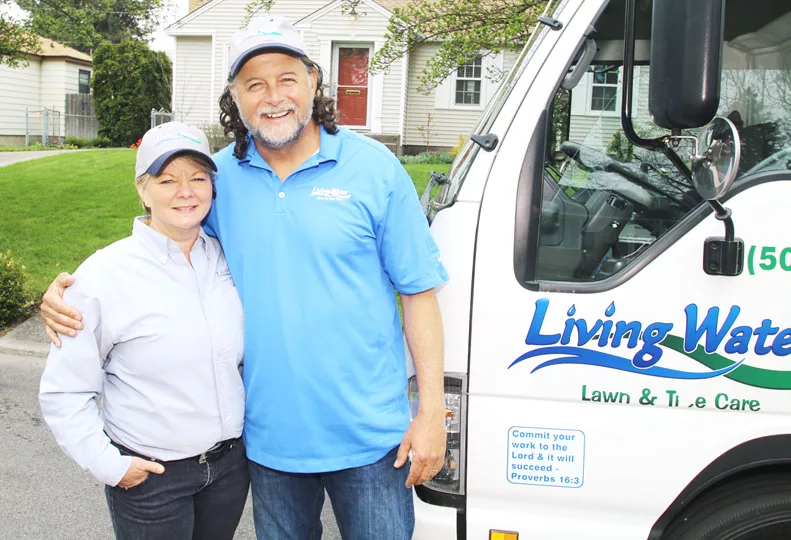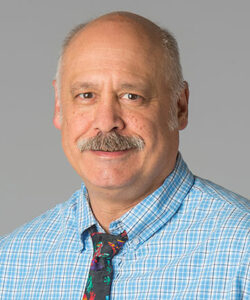Living Water to get greener with new facility
Lawn, tree care company to consolidate operations with $2 million building

Living Water Lawn & Tree Care, which specializes in environmentally friendly lawn and tree fertilizing, is erecting a new building where it will consolidate its operations with two other affiliates, says Mike Fairburn, who co-owns Living Water with his wife, Lisa.
The 20,000-square-foot building under construction at 8227 N. Regal will bring together the operations of the fertilizing, landscaping, and pest-control affiliates that share the Living Water name, Fairburn says.
Ramey Construction Co., of Spokane, is the contractor on the nearly $2 million project, and Mercier Architecture & Planning, also of Spokane, designed it.
Living Water, which the Fairburns founded in 1991, currently is headquartered in a 3,600-square-foot building on the Regal Street property, which the couple bought in 2013 when they expanded mowing and landscaping services.
Living Water’s current fertilizer and chemical mixing facility is in a former fire station at 6925 E. Bigelow Gulch Road. That building has 5,800 square feet of office, garage, and storage space.
Fertilizer-spraying services are still the biggest part of the business, although the newer landscaping and pest-control services are growing at faster rates, Fairburn asserts.
Living Water has about 6,000 customers, he says, adding that the company’s client list has been growing 5 percent to 6 percent annually in recent years.
Most customers are full-service clients, meaning they contract with Living Water for a combination of services.
Regarding the new facility, Fairburn says, “We get to do it from the ground up and make a facility that has a tiny chemical footprint for all of the work we do.”
The new building will have sealed systems for mixing and loading fertilizers and pest-control chemicals.
The system will help protect applicators, he says.
“It will make it a lot safer for employees,” Fairburn says. “All they’ll have to do is plug in the hose and load up the truck, so they’re not getting exposed to concentrates. In the truck, it’s very dilute.”
Another highlight of the new facility is that it will capture and recycle 95 percent of the gray water produced by Living Water so it can be reused rather than go down the drain and into the wastewater system. Gray water refers to wastewater with the exception of sewage. It includes water from sinks, showers, and washing operations.
Fairburn says some gray water will go into fertilizer mixes, and some will be reused to wash equipment.
“We’re trying to recycle water in our existing facilities, but it’s not as good as we’d like.”
Living Water, which has the tag line “Beautiful. Safe. Green. Local.” on its marketing materials, offers organic and natural fertilizer options.
“We believe we do the most organic work of anybody, even though we don’t advertise it,” Fairburn says. “When we say it’s organic, it came through a chicken or a goose or something like that. Organics are more expensive, but we try to keep it as affordable as possible.”
The company emphasizes spot applications rather than broad chemical applications for pest control.
There’s a place for chemicals, as long as they stay where they belong, he asserts, adding, “If it belongs in the lawn, it doesn’t belong in the earth, and it doesn’t belong in the sewer.”
For customers who prefer to avoid any type of chemical pesticide, the best pest control is a thick, dense lawn, he says.
Grass also helps protect the aquifer, the main source of drinking water for most of Spokane and Kootenai counties, Fairburn says.
“Turf is an amazing filter,” he says. “It’s one of the best ways to filter pollutants and things you don’t want in the aquifer.”
Fairburn says his environmental awareness was influenced by his daughter.
“We had talks about taking care of ourselves and the planet,” says Fairburn, who’s 58 years old. “In some ways, it’s a work in progress. Many people my age didn’t really think about it much.”
Prices for Living Water’s services are based on square footage.
Many Living Water jobs are under $50 a visit, and some are in the low $40s, Fairburn says, adding that fees for the smallest properties with older owners on a fixed income could be as low as $30 a visit.
Depending on the size of property and services ordered, typical Living Water jobs take from 20 minutes to two hours to complete.
“We really work on affordability,” Fairburn says. “That’s one of the reasons we work on our volume.”
The company has 25 year-round employees and peaks at 50 to 60 employees from spring through fall. Many employees work 50-hour weeks in the spring, before scaling back to more normal hours by summer.
After being in business a few years, the Fairburns implemented a vacation policy in which even seasonal and part-time employees can take a week of paid summer vacation.
“We were all working hard and I said, ‘Somebody needs to go fishing around here,’” he says. “I don’t think that a lot of companies in seasonal businesses would do that.”
Fairburn says the company’s general manager runs the day-to-day business, while he prefers to work in the field, meeting with customers.
“I still get out and spray, and sometimes my wife comes with me,” he says.
The couple regard many of their customers as close friends.
“We like relationships,” he says. “We believe in being a residential specialist.”
Fairburn says the company will make 60,000 visits this year, including quality inspections, sales calls, and social visits.
“I never dreamed it would be this big,” Fairburn says. “I feel very blessed. Faith is a huge component of life. I like to think of it in our business model.”
The Fairburns are founding pastors of City Church, in the Garland District.
Fairburn says he also enjoys the opportunities to mentor people he works with.
“We’re pretty passionate about creating work and working with people,” Fairburn says. “Teaching the value of work and being a mature man or woman is part of the deal.”
Related Articles
Related Products


_c.webp?t=1763626051)

_web.webp?t=1764835652)
